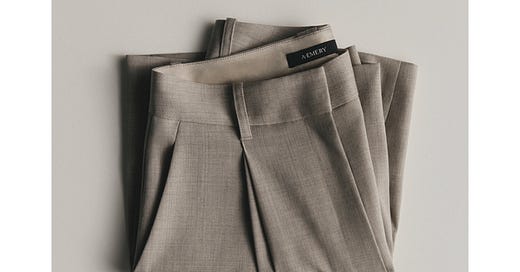Style Strategy 012: How to shop better and identify quality: the fabric edition
You might be surprised. I was.
We all want to buy less, but buy better.
(After all, no one every says they want to buy more and worse.)
But, that doesn’t mean it’s necessarily about spending more per item or only buying designer brands. (Though, whatever, you do you hey.)
It’s about understanding quality, and knowing how to identify it regardless what the label says.
A few months ago, I wrote about how to spot well-made clothes by looking at construction. You all loved it.
This time, I’m getting into FABRIC, because quality starts with what the garment is actually made from.
And, what I learnt did surprise me.
As well as doing my own research, I reached out to designer Anna Quan, as well as other self-confessed ‘fabric fanatics’ such as New York-based commercial fashion director Lizzie Wheeler of
who has worked at LaPointe and Alexander McQueen and sources vintage bridal for Studio Dorothy, and Lauren Trend who heads up marketing at A. Emery and also studied fashion design at RMIT.I have focused purely on how to identify quality fabrics. The questions of sustainability and environmentally consciousness is incredibly complex in fashion. A real quandary! This is a bigger discussion but there is a lot of greenwashing in fashion from big brands and even smaller brands that may not even be malicious, but gaps in understanding.
Ultimately, consuming anything is not great for the environment and there are many trade-offs and other considerations. (I remember interviewing Stella McCartney who explained that organic cotton from Japan might be better for the environment or more appropriate at times, but then the carbon expended to ship it to Europe to be made may outweigh the benefits.)
Ultimately, I believe that the most sustainable thing to do is purchase what you see yourself as using for as long as possible.
First off: check the fabric label — and understand the garment’s purpose
We’re often told to only buy natural fibres, but the reality is more nuanced.
I used to be quick to judge anything synthetic. But, the design and function of a garment matters just as much. “It depends on what the purpose of the garment is,” says Quan. Sportswear and activewear? “They need the durability and moisture-wicking properties of synthetics.”
Trend agrees: “High quality synthetics can mean easier garment care and less (or no) dry cleaning — which can be better for the environment and your hip pocket.”
Blended fabrics can also be beneficial. “For a summer day dress, I’d look for a composition that includes natural fibres for breathability, maybe a little elastane for comfort, and a touch of synthetic to make it more durable and crease-resistant,” says Quan. See — it’s all about what the garment is for.
Synthetics aren’t all evil
Some designs require synthetics.
“Any fabric that needs to snap back into shape — like pleats (think Pleats Please) or super-compact knits — should be synthetic,” says Wheeler.
And when it comes to quality synthetics? There's no one-size-fits-all answer. “I go by feel,” says Wheeler. “A slinky polyester is often preferable to silk jersey, which can pick up sweat stains or snag easily.”
She also calls out acetate as a strong performer.
“It has a drier hand feel than polyester and drapes better.” Italian-made viscose jerseys and acetate-blend satins often outperform silk in both longevity and ease of care.
Quan adds: “I check hand feel, composition, surface finish, and drape. Two synthetics can have the same composition but behave entirely differently. There’s no hard and fast rule — sorry!”






